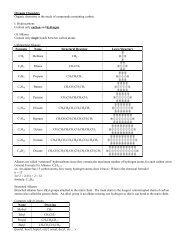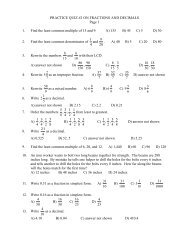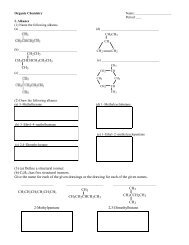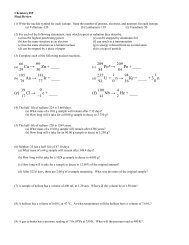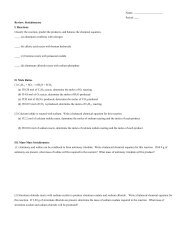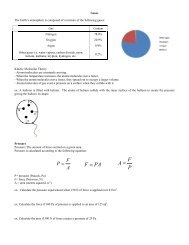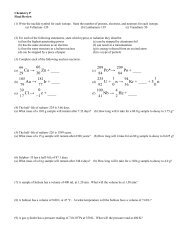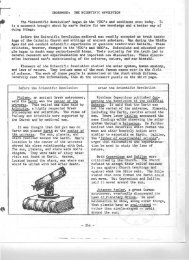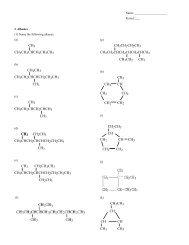- Recognizing the economic issues, representatives of Virginia and Maryland met independently at Mt.Vernon in March 1785 to discuss an agreement over trade on the Potomac. It was a success, which led to acall for a general meeting of the states in Annapolis in September 1786 to discuss trade policies. Only 5delegations ended up <strong>com</strong>ing, but they issued a call for another convention in Philadelphia.- The other states didn’t respond until Shays’ Rebellion gave them a wake-up call. In January 27, 1787Shays led a set of angry western farmers against a federal armory in Springfield. They declared the gov’ttyrannical, using language reminiscent of the Declaration of Independence.- This was the last straw in convincing many a strong central gov’t was necessary, so in May 1787 everystate ex. Rhode Island sent delegates to a Constitutional Convention in Philadelphia.*Debates and Compromises at the Constitutional Convention*- Although most of the delegates to the CC were men of property who favored reforms that would give thenat’l gov’t more authority over taxation and foreign trade, and many were also involved in the creation oftheir state constitutions, they still had some differences in opinion…- For instance, after James Madison proposed the Virginia Plan, delegates from smaller states came upwith the New Jersey Plan. The plans were as follows: Virginia Plan – embodied Madison’s idea of a strong nat’l gov’t and provided for a bicamerallegislature (lower house elected by people, upper elected by lower) with representationproportional to population, an executive elected by Congress, a nat’l judiciary, and aCongressional veto over state laws.New Jersey Plan – was a response to the VP, especially by the small states (didn’t like therepresentation proportional to population deal) who felt the AOC shouldn’t be totally thrownout, just strengthened a little (unicameral legislature w/each state having an equal vote, onlydifference is Congress gets new powers of taxation and trade regulation.)- The eventual <strong>com</strong>promise involved the creation of a bicameral legislature in which one house was to bedirectly elected by the people and the other house was to be elected by the state legislatures. Proportionalrepresentation was allowed for the lower house, but the upper house was eventually declared to be equalrepresentation (2 senators, but they would vote as individuals, not as a block).- On the whole, congressional powers were more limited than in the VP but more flexible than in the NJP.The executive was given primary responsibility for foreign affairs and was designated the <strong>com</strong>mander-inchiefof the armed forces. A key element was separation of powers and checks and balances.- Then there was the whole should we count slaves dilemma…naturally Southern states wanted themcounted for representation purposes and Northern states only wanted them counted for taxation purposes.In the end a slave was declared to be 3/5th of a person. Also, inherent protections of slavery were worked into the Constitution (slave trade couldn’t end for 20 years, fugitive slave laws, etc.)- Anyhow, the CC had its last session on September 17, 1787 and only then was the Constitution madepublic. All that was left was ratification…*Opposition and Ratification*- Later in September the CC submitted the Constitution to the states but didn’t formally re<strong>com</strong>mend itsapproval. The ratification clause of the Constitution stated that it would be approved by special conventionsin at least 9 states (delegates were to be qualified voters – so it was directly based on popular authority.)- As states began electing delegates, two distinct camps formed: Federalists – the Federalists supported the Constitution and stuck by the virtuous, selfsacrificingrepublic led by a merit-based aristocracy idea. Since leaders were to be virtuous,there was no need to fear a strong central gov’t. Besides, there was the separation of powers.Antifederalists – the Antifederalists felt that weakening the states would lead to the onset ofarbitrary and oppressive gov’t power (based on Real Whig ideology.) Antifederalists weregenerally old hard core revolutionaries (Tom Paine, Sam Adams, etc.) and small farmers.- One thing that was big on the Antis agenda was the idea of a Bill of Rights (why doesn’t the Constitutionhave one?), best expressed in the major Anti pamphlet, Letters of a Federal Farmer.- Anyhow, the Federalists won out (duh), partially b/c of the publication of The Federalist and partially b/c ofthe promise to add a bill of rights. Ratification was (prematurely, it turns out) celebrated on July 4, 1788.The Early Republic (1789 – 1800)*Creating a Workable Government Structure*- The First Congress, which first met in April 1789, was mostly controlled by the Federalists [i.e. people whosupported the Constitution and a strong national gov’t].18
- Anyway, Congress had several questions about the structure of the new government to deal with… Revenue – Madison took the here lead by convincing Congress to pass the Revenue Bill of1789, which put a 5% tariff on some imports. Bill of Rights – Madison also took the initiative here and wrote 19 <strong>Am</strong>endments for theConstitution, 10 of which were ratified on December 15, 1791 and became known as the Billof Rights. The Bill of Rights helped rally support for the new gov’t and mitigate AF opposition. Organization of the executive – in the end, Congress agreed to keep the departmentsestablished under the AOC [War, Foreign Affairs/State, Treasury] and just add the attorneygeneral and postmaster general. They also decided that only the President could removeheads of executive departments [since he picked them w/Congress approval]. Organization of the judiciary – this was taken care of by the Judiciary Act of 1789, whichdefined the jurisdiction of the fed. judiciary and established a 6 member SC, 13 district courtsand 3 courts of appeal. It also allowed appeals from state to federal courts w/con. issues.- Only a few important cases concerning the arrangements passed through the SC in the first 10 years:there was only Ware v. Hylton (1796) where the SC declared a state law unconstitutional for the first time,Hylton v. US (1796) where the SC review the constitutionality of an act of Congress for the first time, and,most importantly, Chisholm v. Georgia (1793) which established [though overruled by the Eleventh<strong>Am</strong>endment] that states could be sued in federal courts by cit. of other states.*Domestic Policy under Washington*- After the gov’t was all set up, Washington was elected to be the first President. He was cautious, knowinghe was setting precedents for the future [ex. the Cabinet, the State of the Union Address, no big title forPresident, President not using veto power often].- One of the first things he did was choose the heads of the executive departments: Alexander Hamilton(Treasury), Thomas Jefferson (State), Henry Knox (War), and Edmund Randolph (Attorney). He alsoestablished the Cabinet by using the heads of the executive departments collectively as the chief advisers.- Perhaps Hamilton’s appointment had the biggest impact, as Hamilton had several traits that separated himfrom his contemporaries: (1) he was an all out Federalist [who gives a crap about the states – let’sconsolidate power in the nat’l gov’t], (2) he was very cynical and saw people as being motivated byeconomic self-interest alone [no virtuous <strong>com</strong>mon good for him].- With Hamilton’s outlook in mind, it is not surprising that, when Congress asked him to assess the publicdebt and <strong>com</strong>e up with a plan to fix it in 1789, he came up with some controversial stuff…*Hamilton’s Financial Plan*- Hamilton’s plan had several <strong>com</strong>ponents: Report on Public Credit (1790) – Hamilton proposed that Congress assume state debts,<strong>com</strong>bine them w/the nat’l debt, and redistribute the burden of the debt equally throughout thestates. He also wanted to issue new gov’t securities covering unpaid interest. The opposition tothese measures was lead by Madison, who objected to the Assumption Bill b/c it (1) gave thecentral gov’t too much power and (2) Virginia already paid. He objected to the new securitiesb/c he felt it was ripping off the original holders. In the end the passage of the Assumption Billwas exchanged in a series of <strong>com</strong>promises for the location of the capital [on the Potomac]. The Bank of the United States – soon Hamilton submitted another report on re<strong>com</strong>mending thechartering of a nat’l bank that would be capitalized at $10 million and would mainly be fundedby private investors. The bank would circulate currency and collect and lend $ to the Treasury.But the big question was – did the Constitution allow the creation of the Bank? MADISON (also Jefferson and Randolph) said: no way, if the Constitution doesn’t sayyou can, you can’t. Besides, the elastic clause only allows for necessary bills, and thisis NOT necessary. POV of the strict constructionists. HAMILTON said in his Defense of the Constitutionality of the Bank (Feb. 1791): theCongress has all the powers it is not specifically denied so if it doesn’t say you can’tyou can! POV of the loose constructionists. In the end Washington agreed and the bill was passed and helped the economy. Report on Manufactures (1791) – this last suggestion, which was to encourage <strong>Am</strong>ericanindustry through protective tariffs, was rejected.- A smaller part of Hamilton’s financial plan, the tax on Whisky [to pay for assumption] is worth noting b/c itset off the Whiskey Rebellion in Pennsylvania [where farmers already ticked off b/c the army wasn’tbeating the Miami Confederacy]. At first it was just protests, but in July 1794 violence began [the crap gov’tthat can’t protect us is overtaxing us]. So on August 7, Washington told the rebels to stop and called on13,000 militiamen [he led ‘em, too] to march up there. By the time they got there the rebellion had stopped,19
- Page 3 and 4: Congregationalists (Puritans) - The
- Page 5 and 6: - So the Restoration Colonies, form
- Page 7 and 8: - So in England, where they were lo
- Page 9 and 10: *Colonial Politics 1700-1750: Relat
- Page 11 and 12: - Another ideology that was beginni
- Page 13 and 14: - The Quebec Acts were passed aroun
- Page 15 and 16: - So, by 1782, what had seemed to b
- Page 17: on the economic side, since the gov
- Page 21 and 22: - Adams was still in the early Wash
- Page 23 and 24: *Political Factionalism and Jeffers
- Page 25 and 26: - Samuel Slater set up the first te
- Page 27 and 28: - Court rulings extended the powers
- Page 29 and 30: Revival, Reform and Politics during
- Page 31 and 32: - Anyhow, during his administration
- Page 33 and 34: TEXAS (Southerners) - Texas had bee
- Page 35 and 36: - Anyhow, Pierce’s total support
- Page 37 and 38: They had a smaller everything: smal
- Page 39 and 40: - The two Northern victories at the
- Page 41 and 42: - The result was the Fourteenth Ame
- Page 43 and 44: The Slaughter-House Cases (1873) -
- Page 45 and 46: in the arrest of 8 immigrant radica
- Page 47 and 48: case (1897 - ICC can’t set rates)
- Page 49 and 50: - The Populists prepared to run aga
- Page 51 and 52: - MOST IMPORTANTLY, though, was the
- Page 53 and 54: - So, what led the US to undertake
- Page 55 and 56: - The rebellion, led by Emilio Agui
- Page 57 and 58: - Still, Americans managed to turn
- Page 59 and 60: - So - the point of this episode? B
- Page 62 and 63: *Hoover’s Response*- Poor Herbert
- Page 64 and 65: - In FDR’s second term, however,
- Page 66 and 67: Dominican Republic - When we left i
- Page 68 and 69:
World War II (1941 - 1945)*The Cour
- Page 70 and 71:
- So Truman started off again all c
- Page 72 and 73:
- First of all, the 1950s were (for
- Page 74 and 75:
peace w/Japan that ended occupation
- Page 76:
- France wanted out, so at the Gene



